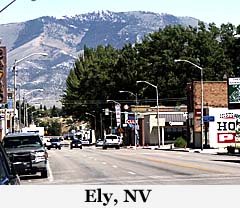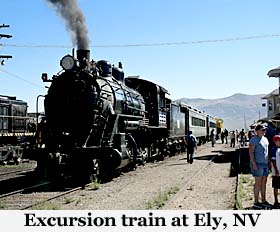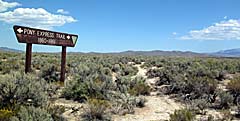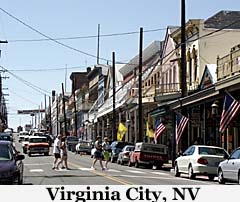
A GUIDE FOR THE INDEPENDENT TRAVELER IN THE AMERICAN SOUTHWEST
"With the completion of the Interstate Freeway System, it became possible to travel all the way across the country, from coast-to-coast, and never see a thing...." Charles Kuralt
Somewhere back many years ago, probably in the 40's or 50's, a reporter from Life Magazine motored across Nevada's Highway 50 and was so unimpressed with it he called it the Loneliest Road in America. Not so much because there wasn't a lot of traffic...there wasn't...but there just wasn't anything to do or see and nobody seemed to be out there in all that vastness.
It didn't take Nevada long to capitalize on what others would have seen as a smirch on their state, they named Highway 50 "The Loneliest Road in America." Nowadays you can even "survive" the trip across Nevada, stopping in several of the towns along the way and get a stamp on a form that you mail in and get a survival certificate. We did that, mailed it in about a month ago and still don't have our certificate.
A lot of people want to travel the highway just to say they did it. If you have more time, you ought to stop along the way and see what the country's all about. We started in Ely (ee-lee), on the eastern side of the state.
on the eastern side of the state.
Mostly a ranching and farming community now, Ely is a typical story of cyclical booms and busts of mining activity dating from the late 1800's. For awhile it was the country's major copper producing region.
Ely has a single, main drag through town, a pleasant, tree lined thoroughfare that never seems too busy. From Ely, it is only a few miles southeast to Great Basin National Park and one of the tallest mountains in Nevada.
If your camping, hiking or biking, there is a world of high mountain country around Ely.
The major attraction in town is the Nevad a Northern Railway. Every mining town had a railroad and they've managed to save a colorful bit of it here. You can take a steam train ride that lasts a couple of hours and goes west out of town to the tailings of the old copper mine. It is not scenic at all and parallels Highway 50 most of the way, but it's only about 2 hours and the volunteers on board dispense a lot of history along the way. Get too bored and they sell beer.
a Northern Railway. Every mining town had a railroad and they've managed to save a colorful bit of it here. You can take a steam train ride that lasts a couple of hours and goes west out of town to the tailings of the old copper mine. It is not scenic at all and parallels Highway 50 most of the way, but it's only about 2 hours and the volunteers on board dispense a lot of history along the way. Get too bored and they sell beer.
The one thing they do that is just worth every cent of the $500.00 or so it costs, is renting the steam engine and driving it yourself...under strict supervision, of course.
The schedule through the rest of September and October is on weekends only. Call for info: 775-289-2085 or their website here.
West, now, on the loneliest road. There is plenty of traffic, actually, but a far cry from an interstate. We had time in one place to set our folding chairs in the middle of the road, set up the timer on my camera, and shoot several shots of us acting like we were enjoying a lazy afternoon in the sun.
The road climbs pretty severely just west of Ely and tops out on a 7500 foot pass. All the way across the state it climbs one pass, then drops into a long valley for a dozen miles, then climbs another pass...
Eureka and Austin are both situated on the western foothills of a couple of those passes. They are colorful, old mining towns that retain a lot of how they must have looked. We spent the night in Eureka and had a few drinks and dinner at the Owl Club, a sort of do-it-all establishment that has a restaurant, bar, dance hall and curio store. Food wasn't bad and company in the bar consisted of a couple of cowboys, a phone co. tech and a little old lady over in the corner playing a slot machine that just kept spitting money at her. Bartender kept delivering her coffee and friendly pats on the sh oulder.
oulder.
Austin is smaller than Eureka. The main street through town is a heavily shaded Highway 50 that proceeds steeply downhill to the west. Fifty million dollars in silver came from Austin mines.
Austin is a quiet, picturesque place. Some of the merchants on main street have taken bright yellow tape and carved out a square of pavement in front of their stores to, I guess, keep anyone from parking there. But it is glaring and an affront to the whole atmosphere. Couple of interesting "junk" shops...excuse me, antique...shops
Now, the loneliest road really gets serious about being straight and monotonous. The passes are lower, shimmers in the distance are more pronounced, dust devils form and dissipate and dance. We pass a sign marking the Pony Express Route back around 1860. Stop, take  a picture and wonder how tough these guys must have been.
a picture and wonder how tough these guys must have been.
Through Fallon. It's a town, home of a naval air station. On to our final destination, Virginia City.
Virginia City is what you have in mind when you see cowboys riding into town for a night on the town. False fronts, boardwalks, lots of saloons and guns. Except for a humongous amount of cars choking the main drag, jockeying for parking places and trying not to hit herds of tourists who've left their common sense at home and dart to and fro into the street from behind parked cars and sides of buildings, this just might be a great movie set.
Well, it's all a little tacky and you can buy more knick-knacks and junk from more...original, one-of-a-kind, only-made-here...stores that you can shake a stick at. But they did take 400 million dollars of ore from the surrounding hills, so there is  history here.
history here.
It is worth the trip, a couple of days or more at least, and if we ever get our certificate back, we can prove we did it.